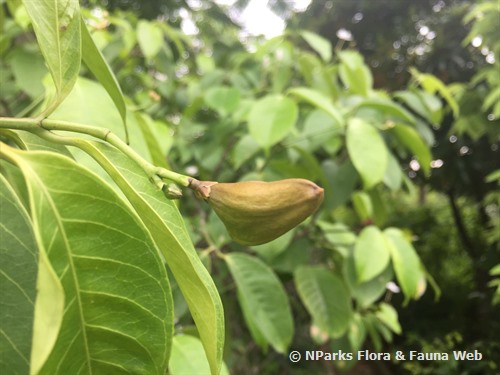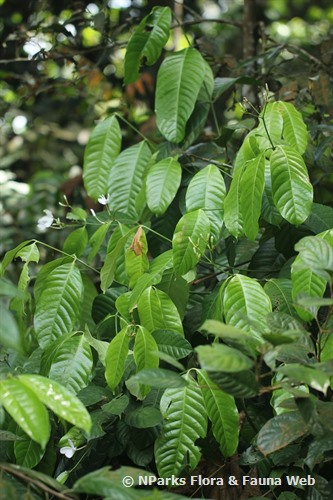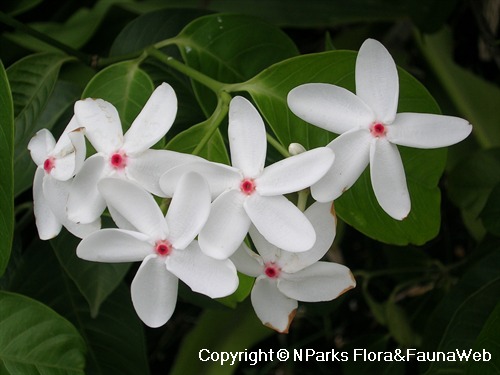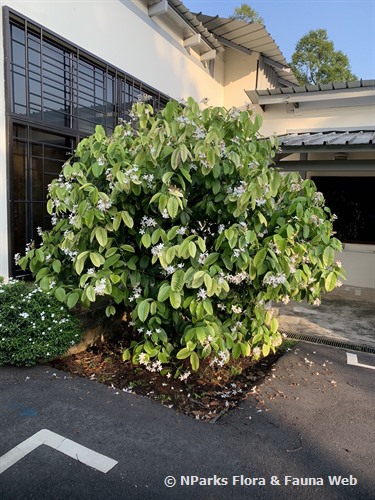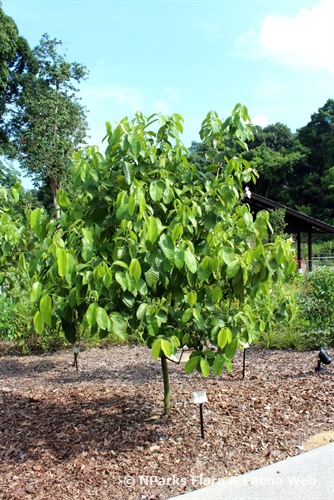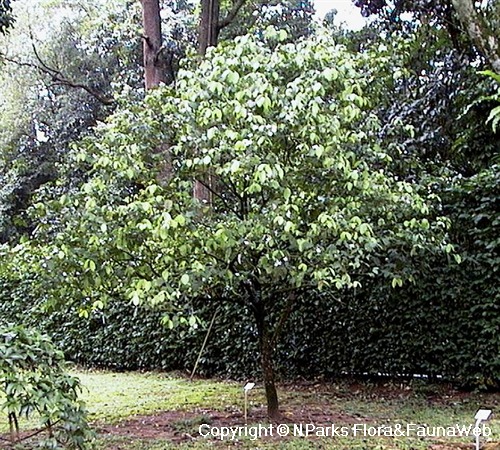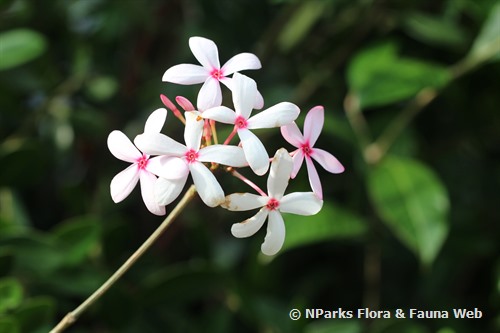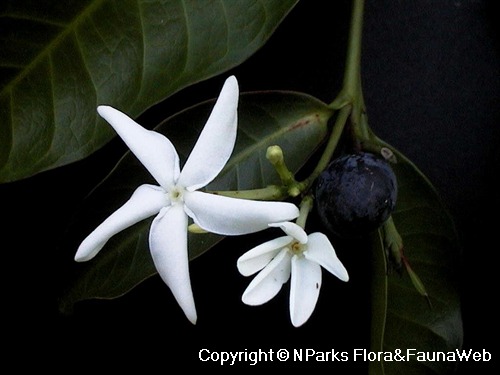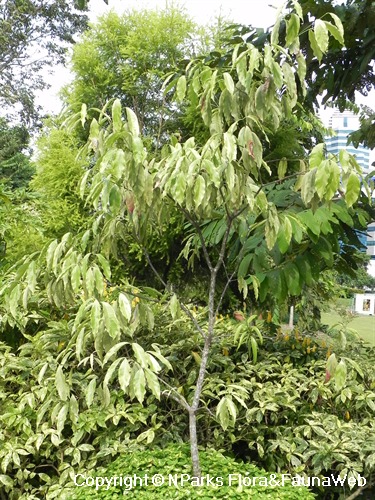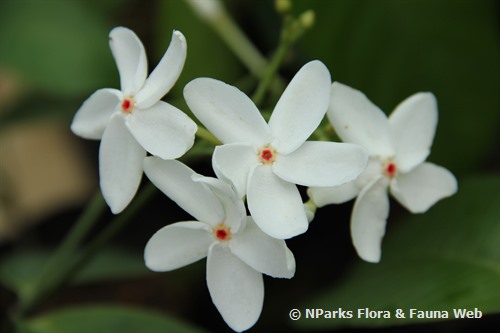
Back
Kopsia singapurensis Ridl.
| Family Name: | Apocynaceae |
| Common Name: | Singapore Kopsia, White Kopsia, Selada |
Kopsia singapurensis is native to Singapore. Its fragrant red and white flower bear the same colours as Singapore’s national flag. While the Singapore flag depicts five stars, the five petals of Kopsia singapurensis are fused (or whimsically ‘united’) at the base. The species is hardy and tolerates waterlogged soils, but is critically endangered in Singapore due to habitat loss.
Name
Classifications and Characteristics
| Plant Division | Angiosperms (Flowering Seed Plants) (Dicotyledon) |
|---|---|
| Plant Growth Form | Shrub, Tree (Small (6m-15m), Shrubby (1m-5m)) |
| Lifespan (in Singapore) | Perennial |
| Mode of Nutrition | Autotrophic |
| Plant Shape | Rounded, Conical |
| Maximum Height | 5 m to 8 m |
| Maximum Plant Spread / Crown Width | 6 m to 8 m |
Biogeography
| Native Distribution | Peninsular Malaysia, Singapore |
|---|---|
| Native Habitat | Terrestrial (Primary Rainforest, Riverine, Freshwater Swamp Forest) |
| Preferred Climate Zone | Tropical |
| Local Conservation Status | Native to Singapore (Critically Endangered (CR)) |
Description and Ethnobotany
| Growth Form | It is a small evergreen tree up to 12 m tall with a conical crown. Its slightly flaky bark is greyish to light silvery brownish. White latex is produced on cut surfaces. |
|---|---|
| Foliage | Its opposite, stalked leaves have rather leathery to leathery leaf blades that are about 6.1–26 by 2.7–11.4 cm. The oval leaf blades are gradually narrowed to a blunt tip of 1.3 cm long. |
| Flowers | Its flowering clusters are 3.5–12.5 cm long. Its flowers are white, each with 5 petals that are fused to form a tube and 5 free lobes. The throat of the tube is red. The flowers are usually 2.5–3.8 cm wide, but they can reach up to 7.6 cm. |
| Fruit | Its dull red fruits are flattened, somewhat triangular in shape, and up to 1.9 cm wide. |
| Others - Plant Morphology | Species endemic to lowland and freshwater swamp forests of Singapore and Peninsular Malaysia. Threatened with habitat loss and categorized as "Critically Endangered" in Singapore. Historical significance: Used as a substitute for ceremonial ribbon during opening of rebuilt herbarium in Singapore Botanic Gardens in 1964.Hardy plant tolerant of waterlogged soils. Suitable as big shrub or small tree for screening and hedge. Cut surfaces produce white latex. |
| Habitat | It grows in lowland evergreen forest, swamp forest and on river banks, up to 600 m in altitude. It occurs locally in Nee Soon Swamp Forest. |
| Cultivation | It can be propagated by seed and stem cutting. |
| Etymology | Latin Kopsia, commemorating J. Kops, a Dutch botanist; Latin singapurensis, from Singapore, referring to one locality in the natural distribution of this species |
Landscaping Features
| Landscaping | It is suitable for parks and waterlogged areas. |
|---|---|
| Desirable Plant Features | Ornamental Flowers, Fragrant (Flowers) |
| Landscape Uses | Suitable for Roadsides, General, Riverine, Shade Providing Tree / Palm, Hedge / Screening, Parks & Gardens, Small Gardens, Marsh / Bog |
| Thematic Landscaping | Naturalistic Garden |
| Usage Hazard - Cons | Irritant - Sap |
| Usage Hazard - Cons Remarks | Latext from cut plant surfaces may be toxic. |
| Plant & Rootzone Preference or Tolerance Remarks | Tolerant of most types of soils, especially waterlogged soils. |
Fauna, Pollination and Dispersal
| Pollination Method(s) | Biotic (Fauna) |
|---|---|
| Seed or Spore Dispersal | Abiotic |
Plant Care and Propagation
| Light Preference | Semi-Shade, Full Sun |
|---|---|
| Water Preference | Moderate Water, Lots of Water |
| Plant Growth Rate | Moderate |
| Rootzone Tolerance | Waterlogged Soils (Drains Site), Easy to Grow, Moist Soils, Well-Drained Soils, Fertile Loamy Soils |
| Maintenance Requirements | Moderate |
| Pruning | Periodic pruning needed to prevent crown from becoming untidy. |
| Propagation Method | Seed, Stem Cutting |
Foliar
| Foliage Retention | Evergreen |
|---|---|
| Mature Foliage Colour(s) | Green |
| Mature Foliage Texture(s) | Leathery |
| Foliar Arrangement Along Stem | Opposite |
| Foliar Shape(s) | Non-Palm Foliage (Oblong, Oval) |
| Foliar Venation | Pinnate / Net |
| Foliar Margin | Entire |
| Foliar Apex - Tip | Cuspidate |
| Foliar Base | Acute |
| Typical Foliar Area | Mesophyll ( 45cm2 - 182.25 cm2 ) |
| Leaf Area Index (LAI) for Green Plot Ratio | 3.0 (Tree - Intermediate Canopy) |
Non - Foliar and Storage
| Trunk Type (Non Palm) | Woody |
|---|---|
| Stem Type & Modification | Woody |
| Root Type | Underground (Fibrous Root, Tap Root) |
Floral (Angiosperm)
| Flower & Plant Sexuality | Bisexual Flowers |
| Flower Colour(s) | Red, White |
|---|---|
| Flower Grouping | Cluster / Inflorescence |
| Flower Symmetry | Radial |
| Individual Flower Shape | Trumpet-shaped |
| Inflorescence Type | Cyme |
| Flowering Period | Free-Flowering |
| Flower Lifespan on Plant | 1 Day |
| Flowering Habit | Polycarpic |
Fruit, Seed and Spore
| Mature Fruit Colour(s) | Red |
|---|---|
| Fruit Classification | Simple Fruit |
| Fruit Type | Fleshy Fruit , Drupe |
Image Repository
Others
| Master ID | 1694 |
|---|---|
| Species ID | 2987 |
| Flora Disclaimer | The information in this website has been compiled from reliable sources, such as reference works on medicinal plants. It is not a substitute for medical advice or treatment and NParks does not purport to provide any medical advice. Readers should always consult his/her physician before using or consuming a plant for medicinal purposes. |

